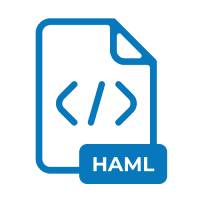.HAML File Extension

Haml Source Code File
| Developer | N/A |
| Popularity | |
| Category | Developer Files |
| Format | .HAML |
| Cross Platform | Update Soon |
What is an HAML file?
In the realm of web development, where efficiency and readability are paramount, developers often seek tools that streamline their workflow.
Among such tools, Haml (HTML abstraction markup language) stands out as a markup language that prioritizes simplicity and elegance. At the core of Haml lies the .HAML file extension, a file format integral to the Haml ecosystem.
In this comprehensive guide, we delve into the origins, structure, advantages, disadvantages, conversion methods, and compatibility of .HAML files.
More Information.
Haml emerged as a response to the cumbersome nature of writing HTML directly. It aimed to streamline the process by providing a concise and intuitive syntax that resembles indentation-based languages like Python.
Initially released as a Ruby gem, Haml quickly gained popularity within the Ruby on Rails community due to its seamless integration and efficiency.
Origin Of This File.
The .HAML file extension is synonymous with Haml, a markup language developed by Hampton Catlin in 2006.
Hampton envisioned a markup language that would simplify HTML coding, reducing verbosity and enhancing readability. This vision culminated in the birth of Haml, with .HAML files serve as the vessel for Haml source code.
File Structure Technical Specification.
.HAML files adhere to a specific syntax designed to mimic the structure of HTML while minimizing the need for explicit tags. The key components of a .HAML file include:
- Whitespace Sensitivity: Indentation plays a crucial role in .HAML files, defining the hierarchy of elements similar to Python or YAML.
- Tag Declaration: Tags in Haml are declared without angle brackets, reducing visual clutter. For instance,
<div>in HTML becomesdivin Haml. - Attribute Assignment: Attributes are assigned using a concise syntax, such as
id="example"becoming%div#example. - Interpolation: Haml supports Ruby interpolation, enabling dynamic content insertion within the markup.
How to Convert the File?
Converting .HAML files to HTML or other formats typically involve using Haml processors or converters. Popular methods include:
- Command-Line Conversion: Utilize command-line tools like
hamlorhaml-railsto convert .HAML files to HTML. For instance,haml input.haml output.htmlgenerates an HTML file from the corresponding .HAML file. - Integrated Development Environments (IDEs): IDEs like Sublime Text, Atom, or Visual Studio Code often feature plugins or extensions that facilitate Haml-to-HTML conversion within the editor environment.
- Online Converters: Various online services offer Haml-to-HTML conversion capabilities, allowing users to upload .HAML files and receive converted HTML documents.
Advantages And Disadvantages.
Advantages:
- Simplicity: Haml simplifies markup creation by minimizing verbosity and reducing the need for repetitive typing.
- Readability: The indentation-based syntax enhances code readability, making it easier to understand the structure of the document.
- Elegant Syntax: Haml’s syntax resembles a natural language, making it intuitive for developers to grasp and use effectively.
Disadvantages:
- Learning Curve: Developers accustomed to traditional HTML may find Haml’s syntax initially challenging to grasp.
- Tool Dependencies: Effective use of .HAML files require integration with Haml processors or compilers, adding a layer of complexity to the development environment.
- Debugging Complexity: Debugging Haml-generated HTML can be challenging, especially for developers unfamiliar with the intricacies of the language.
How to Open HAML?
Open In Windows
- Notepad++
- Visual Studio Code
- Sublime Text
Open In Linux
- Gedit
- Vim
- Emacs
Open In MAC
- TextEdit
- Atom
- Sublime Text













